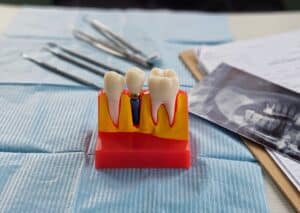A good way to prevent cavities – especially for children – is to apply a dental sealant to your teeth. The sealant acts as a barrier against cavities. It is made from a plastic material and dentists apply it to the area where decay most often occurs in your mouth – on your back teeth’s chewing surfaces.
Although daily flossing and brushing are critical to good oral health, they often miss some of the food particles and plaque in the depressions and grooves of your molars and premolars. Also, while fluoride does a good job of protecting the smooth surfaces of your teeth, but your back teeth don’t get as protected by the fluoride.
Why are sealants important?
The best time to protect your teeth is before they develop decay. Remember, sugar in the food and beverages you consume is used by germs in your mouth to create acids. And it is those acids that cause cavities in your teeth. Therefore, if you apply sealant, it prevents those acids from eating away at your teeth and forcing you to get a filling, a crown, or a cap – all used to restore decayed teeth.
Are sealants only for kids?
While children benefit the most from dental sealants, some adults at risk of cavities or who have deep fissures and grooves in their teeth can benefit from dental sealants. Talk to your dentist about your specific needs.
However, it is highly recommended that children get dental sealants as soon as their permanent molars come in to prevent decay from impacting their teeth. Those initial permanent molars develop in children between 5 and 7 years of age. Their second set of permanent molars come in when they are between 11 and 14 years.
It can be important to also keep baby teeth healthy, since they save space in a child’s mouth for their permanent teeth. For that reason, be sure to check with your dentist to see if dental sealants would be a good idea on your child’s baby teeth – especially if they have deep grooves and pits.
How does a dentist apply dental sealants?
It takes your dentist or dental hygienist just a few minutes to apply a dental sealant to your teeth or your child’s teeth. The process includes:
- Thoroughly cleaning the teeth;
- Drying each tooth, and then wrapping an absorbent material around each tooth to keep it dry;
- Applying an acid solution to each tooth’s chewing surface, which helps the dental sealant bond to the tooth’s surface;
- Rinsing and drying the teeth;
- Painting the dental sealant onto the enamel of each tooth, where it will bond to the tooth and harden. Some sealants use a curing light to help it harden.
What’s the life span of dental sealants?
You can expect the dental sealant applied to your teeth to last up to 10 years. But be sure to have your sealant checked at your regular dental visits to make sure that the sealant hasn’t become chipped or worn away. Repairing sealants is quick, since the dentist or dental hygienist simply paints on additional sealant material.
Can you see sealants?
Dental sealants can be slightly tinted, clear or white. They are visible up close, but generally aren’t noticeable when your child smiles or talks.
Sources: MouthHealthy.org, National Institute for Dental and Craniofacial Research, KnowYourTeeth.com, Colgate, American Dental Association (ADA)


